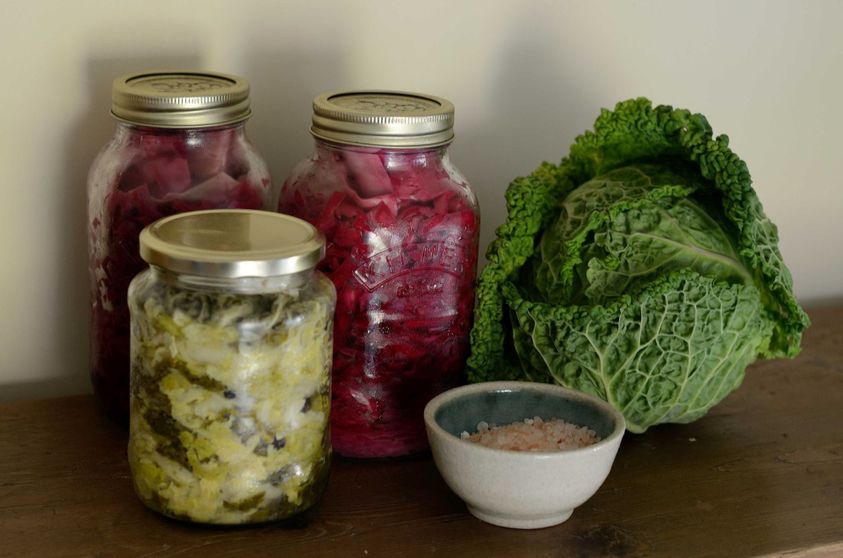Fresh vegetables only stay fresh for so long. Eventually, despite our best efforts, they start to spoil. For those of us with big gardens, we may give away some of our bounty to prevent that from happening. Others can to ensure the longevity of produce for at least a year. Then there’s fermenting, which is a faster preservation method that comes with several health benefits.
What is Fermented Food?
Ever had sauerkraut or yogurt? What about a beer? If so, then you’ve consumed a fermented product. The process, which has been around for thousands of years, turns sugars like glucose, sucrose and fructose into lactic acid to help preserve food while producing intense, vivid flavors. Think about your favorite cheese and how it may have a strong aroma and rich flavor. That’s fermentation at work. The lactic acid also increases the pH of the food, reducing the growth of harmful bacteria and increasing the production of beneficial bacteria.
The Benefits
There are several health benefits in consuming fermented vegetables, including improved digestion. The probiotics created during the process are beneficial to your intestines healthy flora. Some researchers have even found that fermented foods might decrease risk of certain cancers due to the presence of vitamin K2.
How to Get Started
Fermenting vegetables is a painless process so you can get started right away with virtually any produce you have in the kitchen - from tomatoes and cabbage to carrots and cauliflower. There’s not much equipment that you’ll need, either. Make sure you have a knife, glass containers (wide mouth mason jars work great), cloth or coffee paper filter, rubber band and some small rocks - dense, smooth river rocks work best.
Cut the vegetables into small pieces to speed up the fermentation process. Place them into a jar with water, then sprinkle in salt. Make sure you mash the mixture down into the jar well to reduce air pockets. The rocks will serve as a weight to keep the vegetables under the brine where they’ll sit until the beneficial bacteria can do their thing. It’s important everything stays submerged so it doesn’t spoil. Cover with the cloth or coffee filter and secure around the jar with a rubber band to keep out flies.
Ensure the tops of the jars are covered to prevent flies from getting into the mixture.
Depending on the recipe, it may take anywhere from a few days up to a week or two. If the contents smell spoiled, discard and try again. Once the process is complete, move the jar to the refrigerator, where the vegetables will last for a few months. Of course, the process varies slightly by recipe. Here’s a few of our favorites.
Sauerkraut
This simple recipe takes cabbage and produces delicious sauerkraut in just about a week. You’ll need four or five heads of shredded green or red cabbage to get started, as well as a quarter cup of sea salt. Shred the cabbage and rinse then slowly place it in a glass jar, pounding it down with a spoon while sprinkling in sea salt and water. Fill up to no more than one inch below the top to account for the mixture expanding. Ensure the cabbage is submerged by placing rocks on top, then covering with a cloth or coffee filter to keep flies out. Keep in a warm spot of your kitchen for seven to 10 days. After the allotted time, store in the refrigerator where it’ll keep for months.
Salsa
This isn’t your typical salsa - it has a really strong flavor. You’ll need the following list of ingredients:
- 12 cups of tomatoes, chopped
- 2 cups of jalapeños
- 6 garlic cloves
- 2 chopped onions
- ¼ up dried oregano
- 2 tablespoons of cumin
- ¼ cup of sea salt
Combine all of the ingredients (except the sea salt) into a bowl and stir until mixed well. Then transfer to a glass jar and pound it down with a spoon. Between spoonfuls, sprinkle in sea salt and water. Fill up to no more than one inch below the top of the jar, place rocks on top to keep the mixture submerged, then cover with a cloth or coffee filter. Put the jar in a warm place for three to five days, then store in the refrigerator.
Pickles
Fermented pickles are sour and crunchy. We like to flavor ours with garlic, which will also ferment during the process that will pack it with flavor. Here’s what you’ll need:
- 16 cups of pickling cucumbers
- 10 cloves of garlic
- 3 tablespoons of pickling spices
- 5 tablespoons of sea salt
Soak the cucumbers in cold water for two hours and scrub them well. This prevents mold from forming during the process. Place the ingredients into a glass jar with eight cups of water and five tablespoons of sea salt. Stir well and ensure the pickles are covered completely. Weigh down with large rocks that won’t fall between the slices, cover and let sit in a warm place for six to 10 days. Give them a taste test and when they’re fermented to your liking, move them to the refrigerator.







